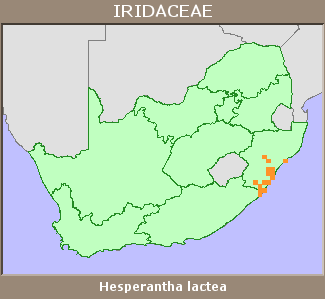|
Scientific Name | Hesperantha lactea Baker |
Higher Classification | Monocotyledons |
Family | IRIDACEAE |
National Status |
Status and Criteria | Least Concern |
Assessment Date | 2021/06/02 |
Assessor(s) | W. Foden, L. Potter & T. Patel |
Justification | This species has an extent of occurrence (EOO) of 27 391 km², and an area of occupancy (AOO) of 100 km². It is known from between 20 and 25 subpopulations and has no threats. It is listed as Least Concern. |
Distribution |
Endemism | South African endemic |
Provincial distribution | Eastern Cape, KwaZulu-Natal |
Range | This species is endemic to South Africa, and is largely a lowland and coastal species, extending from the coast of northern Eastern Cape north to Durban in KwaZulu-Natal. |
Habitat and Ecology |
Major system | Terrestrial |
Major habitats | Grassland, Savanna |
Description | It occurs in marshy grassland. |
Threats |
| This species has no known threats. |
Population |
It is known from 20-25 subpopulations and the population is not threatened. The population trend is stable.
|
Population trend | Stable |
Assessment History |
Taxon assessed |
Status and Criteria |
Citation/Red List version | | Hesperantha lactea Baker | Least Concern | Raimondo et al. (2009) | | Hesperantha lactea Baker | Lower Risk - Least Concern | Scott-Shaw (1999) | |
Bibliography |
Goldblatt, P. and Manning, J.C. 2020. Iridaceae of southern Africa. Strelitzia 42. South African National Biodiversity Institute, Pretoria.
Raimondo, D., von Staden, L., Foden, W., Victor, J.E., Helme, N.A., Turner, R.C., Kamundi, D.A. and Manyama, P.A. 2009. Red List of South African Plants. Strelitzia 25. South African National Biodiversity Institute, Pretoria.
Scott-Shaw, C.R. 1999. Rare and threatened plants of KwaZulu-Natal and neighbouring regions. KwaZulu-Natal Nature Conservation Service, Pietermaritzburg.
|
Citation |
| Foden, W., Potter, L. & Patel, T. 2021. Hesperantha lactea Baker. National Assessment: Red List of South African Plants version 2024.1. Accessed on 2025/10/26 |
 Comment on this assessment
Comment on this assessment


